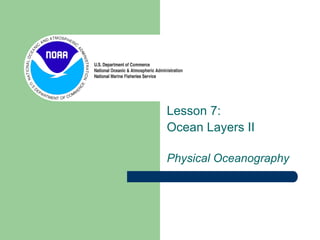Ocean Layers
- 1. Lesson 7: Ocean Layers II Physical Oceanography
- 2. Last class we learned about salinity How is salinity measured? How does salinity affect the density of water? What other variable affects the density of water? 2
- 3. Today we’ll learn more about ocean layers 1. There are three layers in the ocean 2. Temperature typically gets colder as you move from the surface of the ocean down through the middle layer of the ocean. 3. In the very deepest parts of the ocean, temperature and salinity tend to be uniform 3
- 4. Let’s take a journey down through the ocean’s layers The ocean has three layers The surface layer is on top. The surface layer is also called the Epipelagic Zone. The thermocline in the middle, which is made up of the Mesopelagic Zone. The deep ocean is on the bottom. The deep ocean can be further divided into the Bathypelagic, Abyssopelagic and Hadalpelagic Zones. 4
- 5. Let’s take a journey down through the ocean’s layers The depth of each layer can change based on location and season Here, the thermocline ranges from about 50m- 1,000m The majority of ocean water (by volume) can be found in the deep ocean below the thermocline5
- 6. The upper surface of the ocean is called the mixed layer or epipelagic zone. Wind and other forces stir or “mix” this upper layer of water to form a relatively constant temperature throughout Depending on weather, season, and latitude, the mixed layer typically ranges from 10 – 200 m in thickness (Mid-Latitudes) We’ll start our journey in the surface layer (also known as the mixed layer or Epipelagic Zone) 1000 50 Temperature (oC) 5 10 20 30 Depth(m) thermocline mixed deep ocean 6
- 7. Let’s move down into the thermocline The thermocline is a layer of water where temperature changes rapidly with depth The thermocline contains the Mesopelagic Zone In the thermocline, the water quickly gets colder the deeper you go This layer separates the warm, surface layer from the cool, deeper waters 1000 50 Temperature (oC) 5 10 20 30 Depth(m) thermocline mixed deep ocean 7
- 8. What happens as we move below the thermocline? Below the thermocline is the deep ocean – containing the Bathypelagic, Abyssopelagic and Hadalpelagic Zones Water here is cold, dense and salty In the deep ocean, salinity and temperature do not change much as we move downward – they become 1000 50 Temperature (oC) 5 10 20 30 Depth(m) thermocline mixed deep ocean 8
- 9. Don’t get confused with “clines” Remember that thermocline refers to a “gradient” where temperature changes rapidly with depth Halocline is an area where salinity changes rapidly with depth (halo refers to salt) 9
- 10. What is the pycnocline? Pycnocline refers to an area where density changes rapidly with depth Seawater density is determined primarily by temperature and salinity, though the influence of temperature is often greater Just as temperature and salinity influence seawater density, the thermocline and halocline affect the pycnocline Temperature and salinity tend to remain constant below the pycnocline 10
- 11. Student activity Now, answer the multiple choice and short answer questions on the assignment “Tips for the Bowl – Ocean Layers.” 11










